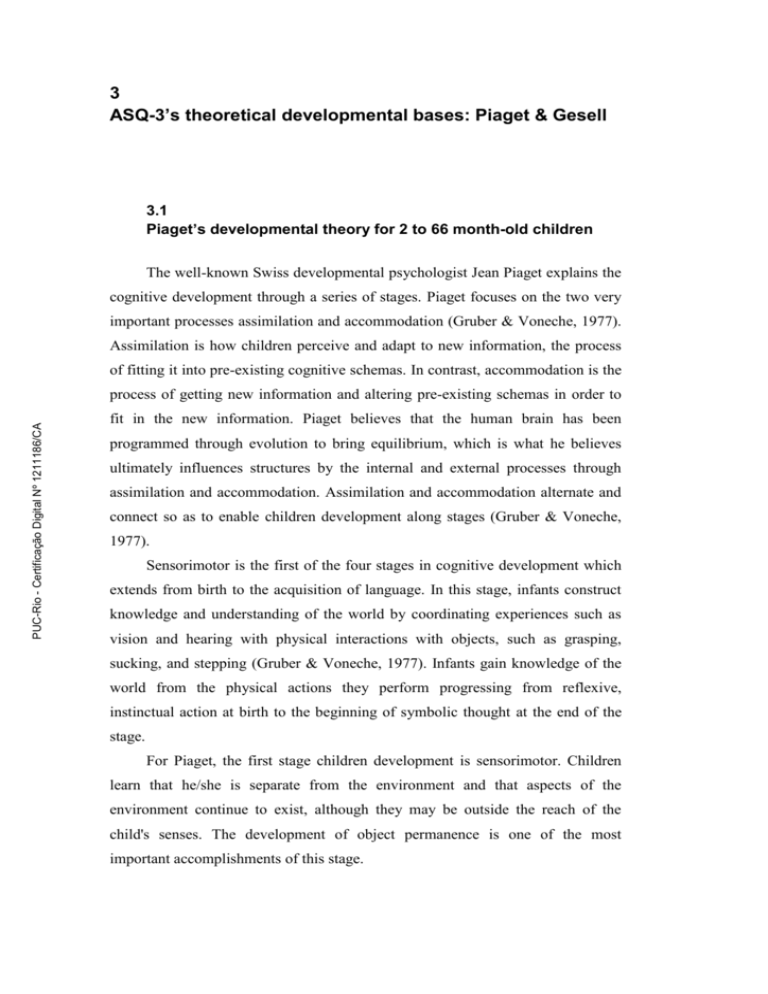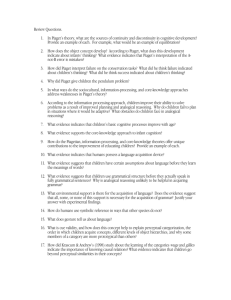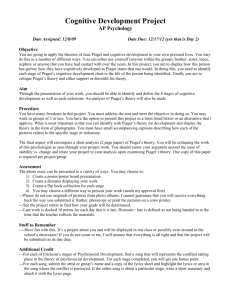3 ASQ-3's theoretical developmental bases: Piaget & Gesell
advertisement

3 ASQ-3’s theoretical developmental bases: Piaget & Gesell 3.1 Piaget’s developmental theory for 2 to 66 month-old children The well-known Swiss developmental psychologist Jean Piaget explains the cognitive development through a series of stages. Piaget focuses on the two very important processes assimilation and accommodation (Gruber & Voneche, 1977). Assimilation is how children perceive and adapt to new information, the process of fitting it into pre-existing cognitive schemas. In contrast, accommodation is the PUC-Rio - Certificação Digital Nº 1211186/CA process of getting new information and altering pre-existing schemas in order to fit in the new information. Piaget believes that the human brain has been programmed through evolution to bring equilibrium, which is what he believes ultimately influences structures by the internal and external processes through assimilation and accommodation. Assimilation and accommodation alternate and connect so as to enable children development along stages (Gruber & Voneche, 1977). Sensorimotor is the first of the four stages in cognitive development which extends from birth to the acquisition of language. In this stage, infants construct knowledge and understanding of the world by coordinating experiences such as vision and hearing with physical interactions with objects, such as grasping, sucking, and stepping (Gruber & Voneche, 1977). Infants gain knowledge of the world from the physical actions they perform progressing from reflexive, instinctual action at birth to the beginning of symbolic thought at the end of the stage. For Piaget, the first stage children development is sensorimotor. Children learn that he/she is separate from the environment and that aspects of the environment continue to exist, although they may be outside the reach of the child's senses. The development of object permanence is one of the most important accomplishments of this stage. 20 Piaget divided the sensorimotor stage into six sub-stages. In sub-stage 1, from birth to 6 weeks, reflexive behaviors lead to coordination of sensation and action and three primary reflexes are described by Piaget: sucking of objects in the mouth, following moving or interesting objects with the eyes, and closing of the hand when an object makes contact with the palm (palmar grasp). Over the first six weeks of life, these reflexes begin to become voluntary actions (the palmar reflex becomes intentional grasping). In sub-stage 2, from 6 weeks to 4 months, first habits and primary circular reactions take place. Babies become able to coordinate sensation and two types of schema: habits – reflex – and primary circular reactions, i.e. reproduction of an event that initially occurred by chance. The main focus is the baby’s body. For PUC-Rio - Certificação Digital Nº 1211186/CA example, babies may repeat the motion of passing the hand before the face. At this phase, passive reactions caused by classical or operant conditioning can begin. Sub-stage 3 happens from 4 to 8 months, when secondary circular reactions and development of habits take place. Babies become more object-oriented, moving beyond self-preoccupation and repeat actions that bring interesting or results (Gruber & Voneche, 1977). This stage is associated with the development of coordination between vision and prehension and three new abilities occur: intentional grasping for a desired object, secondary circular reactions, and differentiations between ends and means. Babies will intentionally grasp the air in the direction of a desired object. Secondary circular reactions, (the repetition of an action involving an external object) begin like, for example, moving a switch to turn on a light repeatedly. The differentiation between means and ends also occurs, one of the most important stages of a child's growth as it signifies the beginning of logic. Sub-stage 4 comprises coordination of secondary circular reactions stages, e.g. hand-eye coordination, from 8 to 12 months. It is associated with the development of logic and the coordination between means and ends, what Piaget calls the “first proper intelligence” (Gruber & Voneche, 1977). This stage marks the beginning of goal orientation, the deliberate planning of steps to meet an objective. Sub-stage 5 is when tertiary circular reactions develop and curiosity for 21 novelty increases, from 12 to 18 months. Infants become intrigued by object properties and by the many things they can make happen. They experiment with new behavior and the stage is associated with the discovery of new means to meet goals. Piaget describes the child here as the “young scientist” conducting pseudoexperiments to discover new methods of meeting challenges (Gruber & Voneche, 1977). The internalization of schemas define sub-stage 6, from 18 to 24 months, when infants develop the ability to use primitive symbols and form enduring mental representations (Gruber & Voneche, 1977). This stage is associated primarily with the beginnings of insight and marks the passage into the preoperational stage. By the end of the sensorimotor period, the child sees objects PUC-Rio - Certificação Digital Nº 1211186/CA as something permanent and separate from the self. Piaget's second stage – pre-operational – starts when the child begins to speak at two years old and lasts until the age of seven. At that point, children do not understand concrete logic nor mentally manipulate information, though there is increase in playing and pretending. Though the children’s play is mainly categorized by symbolic play and manipulating symbols, he/she still cannot see things from different points of view. Their observations of symbols exemplifies the idea of play with the absence of the actual objects involved. The pre-operational stage is sparse and logically inadequate in regard to mental operations. Though he child is able to form stable concepts as well as magical beliefs, he/she is still cannot perform ‘operations’ (tasks done mentally rather than physically). Thinking is still egocentric, meaning the child has difficulty seeing the viewpoint of others. This stage splits into two substages: ‘symbolic function’ and ‘intuitive thought’. The symbolic function substage is when children are able to understand, represent, remember and picture objects in their mind without having the object in front of them. The intuitive thought substage is when children start to ask “why” and “how come”. At about two to four years of age, children cannot yet manipulate and transform information in a logical way. However, they can think in images and symbols, as well as use some language and pretend play. Symbolic play is when children develop imaginary friends or role-play with friends. Children’s play 22 becomes more social and they assign roles to each other. Some examples of symbolic play include playing house, or having a tea party. The quality of their symbolic play can have consequences on their later development as, for example, young children whose symbolic play violent nature tend to exhibit less prosocial behavior and are more likely to display antisocial tendencies in later years (Dunn & Hughes, 2001). In this stage, egocentrism is present and is defined by the fact that children tend to stick to their own viewpoint, rather than consider the view of others since they are not even aware that different viewpoints exists (Gruber & Voneche, 1977). In the experiment known as ‘three-mountain problem’, three views of a mountain are shown to a child and he/she is asked what a doll would see at the PUC-Rio - Certificação Digital Nº 1211186/CA different angles. The child consistently answers according to the position he/she they is seated, regardless of the doll's perspective. Egocentrism also causes a child to believe that if he/she likes something, so will others. Similarly, preoperational children use their own views – like in egocentrism – to explain cause-and-effect relationships. Three main concepts of causality displayed by children in this stage are animism, artificialism and transductive reasoning (Gruber & Voneche, 1977). Animism is the belief that inanimate objects are capable of actions and have human qualities, like children believing that stars twinkle in the sky because they are happy. Artificialism refers to environmental characteristics been attributed to human actions or interventions – it is windy outside because someone is blowing very hard. Finally, precausal thinking is categorized by transductive reasoning which is when a child fails to understand properly the relationship between cause and effect. For example, if a child hears the dog bark and then a balloon popped, the child would conclude that the balloon popped because the dog barked, (Gruber & Voneche, 1977). Between ages 4 and 7, interest of reasoning emerges and the child wants to know ‘why’, what Piaget called “intuitive substage” (Gruber & Voneche, 1977). Children realize they have a lot of knowledge, but cannot realize how they acquired it. Centration, conservation, irreversibility, class inclusion, and transitive inference are characteristics this stage. 23 Centration is the act of focusing on one characteristic of a situation, while disregarding all others. Conservation is the awareness that altering a substance's appearance does not change its basic properties. The following Piaget’s experiment exemplifies both concepts. A child is presented with two identical beakers containing the same amount of liquid, what is initially clear to the child. When one of the beakers is poured into a taller and thinner one, children who are under seven or eight say that the taller beaker holds the larger quantity (centration), without taking into consideration the fact that both beakers had the same amount of liquid (conservation) just before. ‘Irreversibility’ is closely related to ‘centration’ and ‘conservation’. It refers to a child being unable to mentally reverse a sequence of events. The child PUC-Rio - Certificação Digital Nº 1211186/CA does not realize that if the sequence of events with the beaker was reversed (the water from the tall beaker was poured back into the original one), the same amount of water would exist. ‘Class inclusion’ refers to children’s inability to focus on two aspects of a situation, when one category can contain several different subcategories or classes (Gruber & Voneche, 1977). For example, a four-year child is shown a picture of 8 dogs and 3 cats but, if asked, cannot say if there are “more dogs” or “more animals”, being likely to answer “more dogs”. This is due to her difficulty focusing on the two subclasses (dogs and cats) and the larger class (animals) at the same time. ‘Transitive inference’ is using previous knowledge to determine the missing piece, using basic logic, as when a child cannot say that “A” is greater than “C” when presented with the information “A” is greater than “B” and “B” is greater than “C”. 24 3.2 Gesell’s developmental theory for 2-66 month children Arnold Gesell, as director of the Yale Clinic of Child Development for 37 years, observed and registered the changes along human growth. As a maturationist, he emphasized physical and mental growth establishing typical behaviors throughout childhood. He categorized these typical behaviors into 10 major areas – the gradients of growth – that became patterns according to which development would unfold, from birth to adolescence. They include the evaluation of motor characteristics (bodily activity, eyes, and hands), personal hygiene (eating, sleeping, elimination, bathing and dressing, health and somatic complaints, and tensional outlets), emotional expression (affective attitudes, PUC-Rio - Certificação Digital Nº 1211186/CA crying, assertion, and anger), fears and dreams, self and sex, interpersonal relations (mother-child, child-child, and groupings in play), play and pastimes (general interests, reading, music, radio, and cinema), school life (adjustment to school, classroom demeanor, reading, writing, and arithmetic), ethical sense (blaming and alibiing; response to direction, punishment, praise; response to reason; sense of good and bad; and truth and property), and philosophic outlook (space, language and thought, war, death, and deity). For Gesell, development is thought to process through an orderly sequence – babies first learn how to roll on their backs, then sit, creep, walk, run and climb. That is primarily determined by biological maturation and may be altered only to some extent. His theory is especially useful for examining motor development. Gesell conceived five principles of development thought to be characteristic of every child’s growth pattern in motor, adaptive, language and personal-social behavior. They describe typical development as a predictable and orderly process, that is, it should be possible to predict how most children will develop, that they will develop approximately at the same rate time as other children. Gesell’s five principles according to which children develop are: developmental direction, reciprocal interweaving, functional asymmetry, individual maturation and self regulatory fluctuation. The principle of developmental direction states that development unfolds in a systematic direction as a programmed function of genetic mechanisms 25 (Wolraich, 2003). Development follows two patterns. Firstly, in the cephalocaudal phase, it happens from head to down. An example would be the embryo’s arm buds appearing before the leg buds. The same way the infant shows voluntary motor control of the head and shoulders before control of the lower limps. According to Gesell’s second pattern, development is proximodistal. That means it proceeds from near the organism to the periphery. In the embryo, for example, the spinal cord develops before the arms buds as well as in the early development, infants gain control over the entire arm before finer control of the individual finger (Wolraich, 2003). Similarly, to pick up an object the child initially uses his/her whole hand. It is only possible to pick up a object using the fingers at a later stage. PUC-Rio - Certificação Digital Nº 1211186/CA The principle of reciprocal interweaving states that inhibition, exhibition and excitation of different muscles operate complementarily to produce a different movement. In walking and handedness, walking is viewed as a series of alterations between flexor (bending) and extensor (extending) movements of arms and legs in coordination. The movements oppose each other but result in integration and progression to a mature movement (Wolraich, 2003). This can be observed in babies using two arms when reaching for small objects toward the end of their 1st year (Bremner &Wachs, 2011). This tendency is associated with the development of a new motor skill, specifically, the emergence of upright locomotion, sitting, crawling, or walking. The principle of functional asymmetry describes development as a sequence. Certain prerequisite physiological structures must be present for other development or learning to occur. For example, it is important for an infant to have certain degree or of trunk stability for walking to occur (Wolraich, 2003). Gesell illustrates this complex principle with a basic response called the tone neck reflexes. This reflex is present when the child assumes the position like that of the fencer, with the head turned one side, one arm extended to that side and the leg one that side straight, and the other leg bent at the knee and the other arm folded across the chest. This behavior is a precursor to later development of systemically reaching. The principle of self regulatory fluctuation is similar to the principle of 26 interweaving since it understands development as alternating periods of stability and instability (Wolraich, 2003). There is a distant sequence of stages that occurs and allows the organism or function while accommodating growth (Wolraich, 2003). The principle of self individualizing maturation also describes development as a process of sequential patterning. The child’s environment and the learning that occurs as a result of the child’s experiences largely determine whether the child will reach optimal development. A stimulating environment and varied experiences allow a child to develop to his or her potential. Stimuli have impact over the changes in the brain and nervous system that occur along maturation and consequently help children improve cognitive and motor skills. PUC-Rio - Certificação Digital Nº 1211186/CA Language acquisition is also studied by Gesell. According to his timetable, the essential milestones for language development happen between the ages of 40 weeks and 5 years. A child begins to produce meaningful sounds, simple words or childish nicknames at 40 to 50 weeks of age. Between one to two years old, the child's vocabulary expands and pronunciation becomes clearer. Infants begin to use longer phrases and very simple sentences. From two to three years of age, the child begins to communicate in complete sentences. Language becomes a tool for thinking and the child moves beyond very simple ideas to more abstract ones. From three to four years old, the child tends to ask many questions, using language as a means to expand his/her knowledge of the world. He or she will also become able to make generalizations. From four to five years of age the child has basic mastery of the language.








